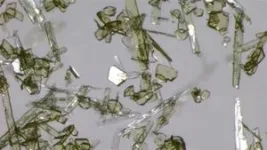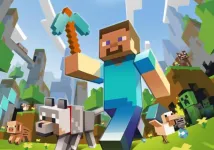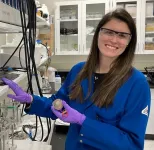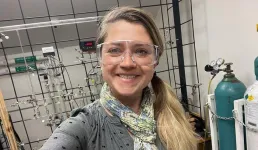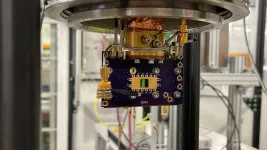(Press-News.org) Scientists have developed new light-sensitive chemicals that can radically improve the treatment of aggressive cancers with minimal side effects. In mouse tests, the new therapy completely eradicated metastatic breast cancer tumors.
The novel chemicals, called cyanine-carborane salts, and their role in the next-generation of cancer treatments, are described in a new article published in Angewandte Chemie, a journal of the German Chemical Society.
Photodynamic therapy, or PDT, has been used for decades to treat forms of skin and bladder cancers. It works by flooding a patient’s body with light-sensitive chemicals that accumulate in cancer cells. Shining a light on the patient activates the chemicals and kills the diseased cells.
The light causes the chemicals to generate highly reactive oxygen molecules – like tiny biochemical firecrackers – that break down cancer cells from the inside while leaving healthy cells unharmed.
It is a useful therapy with several drawbacks that limit its effectiveness, including prolonged light sensitivity, poor tissue penetration and off-target toxicity. These drawbacks can prevent complete tumor eradication and may lead to a recurrence of the cancer.
The multidisciplinary research team is composed of scientists from University of California, Riverside and Michigan State University, or MSU.
“Cyanine-carborane salts minimize these challenges, offering a safer, more precise way to destroy tumors completely while sparing healthy tissue,” said Professor Sophia Lunt, MSU cancer researcher and co-principal investigator of the project.
The researchers said current FDA-approved PDT chemicals remain in the body for extended periods of time. After treatment, patients have to stay in the dark for two to three months because even low levels of light will cause them to become blistered and burned.
In contrast, the researchers found that cyanine-carborane salts flush out of the body more quickly, remaining only in the cancer cells requiring treatment.
Vincent Lavallo, UCR chemistry professor and co-prinicipal investigator, is an expert on the synthesis of carboranes.
“The most interesting thing is the targeting ability of this substance we made to go right where it’s needed and stay there while the rest passes through. That way you’ll only kill the cells right where the cancer is but not harm the patient,” Lavallo said.
Lavallo worked together with Richard Lunt, MSU endowed professor of chemical engineering, to develop the cyanine-carborane salts.
Unlike conventional PDT agents, the salts exploit a natural vulnerability in cancer cells. They’re taken up by proteins called OATPs that are overexpressed in tumors. This allows for precise targeting without the need for costly additional chemicals currently used with PDT to help target the cancer cells.
Traditional PDT is also limited in its ability to treat deep-seated tumors because it works with wavelengths of light that only penetrate a few millimeters into the body. Once inside cancer cells, cyanine-carborane salts can be activated by near-infrared light that is able to move deeper into tissues. This could expand the range of cancers that could be treated.
Given their success, researchers are encouraged to continue the research and try to expand the types of cancer therapies the salts can be used with. It may be possible to alter the salts so that they can be used with energy sources other than light that penetrate even more deeply into the body.
“Our work offers a targeted, safe, and cost-effective treatment for aggressive breast cancers with limited treatment options,” said Amir Roshanzadeh, paper first author and MSU cell & molecular biology graduate student. “It also opens the door to breakthroughs in other approaches for cancer therapy and targeted drug delivery.”
END
Breast cancer treatment advances with light-activated ‘smart bomb’
Breakthrough makes photodynamic therapy safer, more effective
2025-02-11
ELSE PRESS RELEASES FROM THIS DATE:
JSCAI article at THT 2025 sets the standard for training pathways in interventional heart failure
2025-02-11
WASHINGTON–Interventional heart failure (IHF) has rapidly evolved as a critical subspecialty within cardiology at the crossroads of advanced heart failure and interventional cardiology. The increasing complexity of patient care—spanning both pharmacological treatments and an expanding array of device-based therapies—has underscored the urgent need for a standardized approach to training and career development in this field.
That’s the message from experts in a comprehensive review, “Charting the Course for Careers in Interventional Heart ...
Engineering biological reaction crucibles to rapidly produce proteins
2025-02-11
Biomedical engineers at Duke University have demonstrated a new synthetic approach that turbocharges bacteria into producing more of a specific protein, even proteins that would normally destroy them, such as antibiotics.
The technique directs bacteria to produce synthetic disordered proteins that bunch together to form compartments called biological condensates. When these compartments trap mRNA carrying instructions for specific proteins together with the machinery needed to implement them, they can greatly enhance the rate of protein production.
The technique could be a boon to industries that use bacteria to produce a wide range of products such as pharmaceuticals, ...
Minecraft: a gamechanger for children’s learning
2025-02-11
It’s the globally popular video game that’s captured the attention of more than 141 million active players, but Minecraft can also play a significant role in shaping children’s development, social interactions, and cognitive learning, say researchers at the University of South Australia.
Published in the new book Children’s online learning and interaction, the study found that when children engage in collaborative Minecraft play, they foster teamwork, communication, and social skills as players exchange ideas and problem-solve ...
Presidential awards spotlight naval research excellence
2025-02-11
WASHINGTON, D.C. – An alternative energy mechanical engineer, two aerospace engineers, and a corrosion research engineer received the highest honor bestowed to early career U.S. government scientists and engineers.
These four U.S. Naval Research Laboratory (NRL) researchers each received a Presidential Early Career Award for Scientists and Engineers (PECASE) for their research on next generation energy storage solutions, solid fuel combustion for use in high-speed propulsion devices, solving large-scale ...
SETI Institute names first Frank Drake Postdoctoral Fellow
2025-02-11
February 11, 2025, Mountain View, CA -- The SETI Institute awarded the first Frank Drake Postdoctoral Fellowship to Dr. Anastasia Yanchilina. Yanchilina will focus on distinguishing biosignatures from false positives across space and time. Her research combines experimental and analytical research to refine biosignature detection techniques. She will conduct lab experiments to generate key mineral analogs and study Earth’s extreme environments to understand what potential signs of life to look for on other planets.
“It has long been my scientific dream to explore whether life exists ...
From photons to protons: Argonne team makes breakthrough in high-energy particle detection
2025-02-11
Particle detectors play a crucial role in our understanding of the fundamental building blocks of the universe. They allow scientists to study the behavior and properties of the particles produced in high-energy collisions. Such particles are boosted to near the speed of light in large accelerators and then smashed into targets or other particles where they are then analyzed with detectors. Traditional detectors, however, lack the needed sensitivity and precision for certain types of research.
Researchers at the U.S. Department of ...
Cancer’s ripple effect may promote blood clot formation in the lungs
2025-02-11
Blood clots form in response to signals from the lungs of cancer patients—not from other organ sites, as previously thought—according to a preclinical study by Weill Cornell Medicine, Memorial Sloan Kettering Cancer Center and University of California San Diego Health. Clots are the second-leading cause of death among cancer patients with advanced disease or aggressive tumors.
While blood clots usually form to stop a wound from bleeding, cancer patients can form clots without injury, plugging up vessels and cutting off circulation to organs. The study, published Feb. 11 in Cell, shows that tumors drive clot formation (thrombosis) by releasing ...
New UVA clinical trial explores AI-powered insulin delivery for better diabetes care
2025-02-11
For people living with Type 1 Diabetes (T1D), keeping blood sugar levels in check is a constant challenge. A new clinical trial at UVA is aiming to simplify diabetes management by testing an innovative AI-powered device designed to improve automated insulin delivery.
The trial is co-led by several School of Data Science faculty, including Assistant Professor of Data Science Heman Shakeri; Boris Kovatchev, founding director of the UVA Center for Diabetes Technology, a professor at the School of Medicine and professor ...
New technology could quash QR code phishing attacks
2025-02-11
The ubiquitous QR (“quick response”) codes that appear on everything from parking pay stations to soda cans and promotional flyers have become an increasingly popular target for cybercriminals to exploit through QR code–based phishing attacks, also known as “quishing.” Bad actors will place phony QR codes that direct smartphone users to enter their sensitive private information in fake websites masquerading as bank websites, parking enforcement offices, or other seemingly ...
Study reveals direct gut-brain communication via vagus nerve
2025-02-11
A new study in an animal model provides direct evidence for the role of the vagus nerve in gut microbiome-brain communication, addressing a critical gap in the field.
The research, led by Kelly G. Jameson while a PhD student in the Hsiao Lab at UCLA, demonstrates a clear causal relationship between gut microbiota and vagal nerve activity.
While the vagus nerve has long been thought to facilitate communication between the gut microbiome—the community of microorganisms living in the intestines—and the brain, direct evidence for this process ...
LAST 30 PRESS RELEASES:
Antibiotic resistance is ancient, ecological, and deeply connected to human activity, new review shows
Vapes, pouches, heated tobacco, shisha, cigarettes: nicotine in all forms is toxic to the heart and blood vessels
From powder to planet: University of Modena engineers forge a low-carbon future for advanced metal manufacturing
Super strain-resistant superconductors
Pre-school health programme does not improve children’s diet or physical activity, prompting call for policy changes, study finds
Autumn clock change linked to reduction in certain health conditions
AI images of doctors can exaggerate and reinforce existing stereotypes
Where medicine meets melody – how lullabies help babies and parents in intensive care
We may never be able to tell if AI becomes conscious, argues philosopher
AI video translation shows promise but humans still hold the edge
Deep ocean earthquakes drive Southern Ocean’s massive phytoplankton blooms, study finds
Without campus leftovers to pick through, the beaks of this bird changed shape during the pandemic
High-dose antibiotic does not reduce mortality in tuberculous meningitis
How many insects fly in the sky above the USA?
Could cheese protect your brain health?
Who faces more difficulty recovering from stroke?
Colliding galaxies create the brightest, fastest growing black holes at their center
New BrainHealth research reveals tradeoffs on sleep with cannabis use for chronic pain
Aging-US now on ResearchGate, enhancing visibility for authors and readers
'Molecular glue' stabilizes protein that inhibits development of non-small cell lung cancer
Mount Sinai Health System is recognized in 2025 Chime Digital Health Most Wired survey
From prey to predator: How carnivores spread beneficial fungi
Menopause symptoms may be frequent and have negative effects, according to female endurance athletes
US Congressmembers’ responses on X to mass shooting events differ along party lines
KAIST-UEL team develops “origami” airless wheel to explore lunar caves
Individual genetic differences render some therapies ineffective
Engineering dendritic cells boosts cancer immunotherapy
Sophisticated neuroimaging reveals PTSD in WTC responders is linked to measurable physical changes in brain structure
Health policy experts identify promising strategies for providing health care to homeless people
Study explores role of neutrophils in canine atopic dermatitis
[Press-News.org] Breast cancer treatment advances with light-activated ‘smart bomb’Breakthrough makes photodynamic therapy safer, more effective

